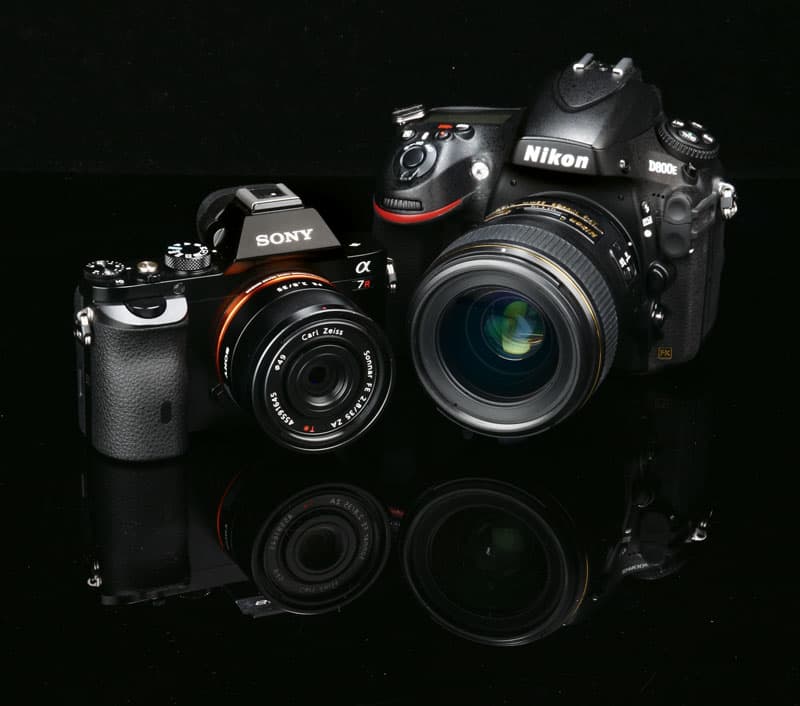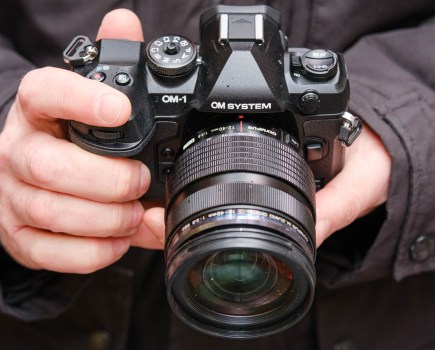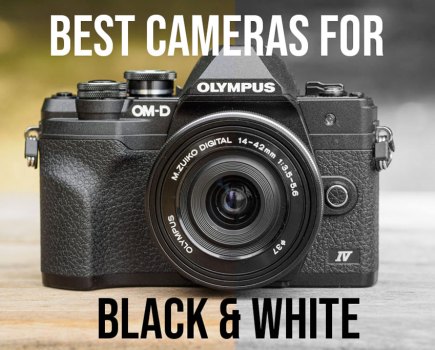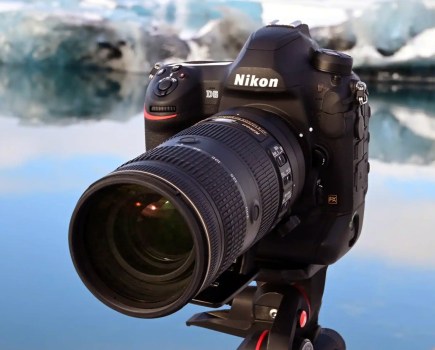Image: Despite being a fraction of the size of the Nikon D800E, the Sony Alpha 7R features a full-frame sensor with an impressive 36.4-million-pixel resolution
When Nikon announced the launch of the D800 alongside the D800E in early 2012, it was hard to believe that behind the F-mount lay a 36.3-million-pixel sensor – the highest resolution of any DSLR at the time of its launch, and a claim that still holds true today. With both cameras becoming the hot topic of conversation among photographers, the photo press and the trade alike, it sparked a number of questions about whether such a high resolution was needed, how the enormous file sizes would be handled, and perhaps more fundamentally, who Nikon were trying to target as their audience with these high-resolution beasts.
Two years on, and we’re left questioning why we ever doubted the D800/D800E’s existence. Both have won an endless list of accolades, proving to be the choice of professional and enthusiast photographers around the world who demand the finest levels of detail from a scene using a camera that ticks virtually every box. I say virtually every box, because two things the D800 and D800E weren’t successful at were being small and lightweight.
This opened up a gap for another manufacturer to take on Nikon’s DSLRs. The manufacturer was Sony, which late last year released the Alpha 7R – the world’s smallest full-frame system camera with an almost identical resolution to the D800/D800E, with 36.4 million pixels. With a promise of delivering Nikon D800/D800E quality in a smaller and more lightweight system, has Sony succeeded in producing the best high-resolution system camera to date?

Image: The Nikon D800E has a tendency to overexpose by approximately 2/3 stop compared to the Sony Alpha 7R. This is obvious in the above image when studying shadow areas
Low-pass filters
Before we delve deeper into the differences between the two cameras, it is important to clarify the reason for testing the Nikon D800E, rather than the D800, against the Sony Alpha 7R. The D800E is identical in every way to the D800 apart from the fact that it has a second optical low-pass (anti-aliasing) filter, which cancels out the effects of the first. The result is the equivalent of the D800E having no low-pass filter at all (which is the case with Alpha 7R), and leads to an increase in resolution and sharpness.
To ensure that our test was strictly comparative, we tested both camera models with each manufacturer’s best prime lenses in the same focal length – the D800E with the Nikkor AF-S 35mm f/1.4 G, and the Alpha 7R with the Carl Zeiss Sonnar T* FE 35mm f/2.8 ZA.
The sensor
The Sony Alpha 7R and Nikon D800E feature identical 36.8-million-pixel (actual) CMOS sensors, although there is a negligible difference in effective pixel resolution – 36.4 million pixels on the Alpha 7R and 36.3 million pixels on the D800E. As both sensors also share identical dimensions (35.9x24mm), it supports suspicions that each camera uses the same Sony-made unit. It’s interesting that until now, Sony has never used this sensor in its Alpha line, instead opting to use its 24.3-million-pixel chip – presumably due to the fact that it sold exclusive rights of the 36.3-million-pixel sensor to Nikon for a limited time period, which has since expired.
Unsurprisingly, both sensors produce a maximum image size of 7360×4912 pixels. Although both cameras essentially have the same ISO sensitivity output of 50-25,600, the D800E’s native sensitivity range runs from ISO 100-6400, which means you must use the L1.0 or H2.0 settings to
access the equivalents of ISO 50 and ISO 25,600 respectively.
The key difference regarding the sensor is how it is positioned behind the lens mount of each camera. Whereas the D800E’s chip is set back behind the mirror and shutter mechanism, the Alpha 7R’s sensor is much more exposed, sitting directly behind the smaller E-mount – one of the main contributors to its compact size. Although the Alpha 7R is compatible with Sony’s E-mount NEX-series lenses, these were originally designed for use with an APS-C sensor and, as such, they don’t have a large enough image circle to cover a full-frame sensor entirely. To overcome this, Sony’s new FE series of full-frame lenses should be used. However, with a limited range of just four optics at present, the Alpha 7R starts on the back foot compared to the D800E, which is supported by Nikon’s vast range of FX-format lenses.
Features

Image: The in-camera processing that is applied to the 7R’s images is a touch more agressive than the D800’s. This can be seen in a magnified view of the JPEG images shown here
Sensor and lens compatibility aside, the D800E uses an Expeed 3 image-processing engine with 14-bit A/D conversion and 16-bit image processing, whereas the Alpha 7R features Sony’s new Bionz X processor with 14-bit raw output. Both support the use of optically image stabilised and non-stabilised lenses, with Nikon’s VRII system and Sony’s SteadyShot system claiming to allow users to shoot handheld up to 4 stops slower than would otherwise be possible.
The trade-off for choosing a camera with such a high resolution is its continuous speed. The large file sizes demand so much from the processor that neither camera can shoot at what we’d call a breathtaking pace. The D800E is capable of 4fps in its continuous high speed (CH) mode, which is a speed matched by the Alpha 7R set to its speed priority continuous mode. Loaded with identical SanDisk ExtremePro SDHC cards, the Alpha 7R sustained a continuous burst of 15 raw files at 4fps, which is a lower figure than the 18 raw frames recorded by the D800E. Set to raw+JPEG, the Alpha 7R rattled out the same number of frames, while the D800E’s count reduced to 16 frames. Switching to JPEG only, the D800E shot 32 frames at 4fps as opposed to 17 frames on the Alpha 7R.
As the Alpha 7R is smaller than the D800E, it has a smaller battery. Its rechargeable Li-Ion battery manages 270 shots compared to the D800E’s battery, which is rated to more than 900 shots. To increase the battery stamina of the Alpha 7R, the VG-C1EM battery grip (£259) would be a worthy purchase. This, just like the camera body, is sealed to protect against dust and moisture.
Build and handling
As you would expect from cameras aimed at targeting enthusiasts as well as professionals, the D800E and Alpha 7R feature robust bodies with magnesium alloy used in their construction. Added to this, both feature weather seals to prevent dust, dirt and moisture creeping past panels to the internals. This weather-sealing provides a full sense of security when the cameras are used in extreme and demanding conditions, and even when shooting in a downpour both shrugged off moisture with no apparent signs of water damage.
On the scales, the Alpha 7R body weighs 493g less than the D800E body, yet despite this considerable weight saving the Alpha 7R feels just as rigid. The Alpha 7R does lack the ‘muscular’ quality of the D800E that some photographers prefer, but the handgrip has been sculpted in such a way that your hand wraps around it very comfortably.
My only concern about the Alpha 7R’s design lies with some of its buttons and controls. For example, the exposure-compensation dial on the corner of the body is easily knocked when in use. Also, the menu and zoom buttons, as well as the aperture-control dial, could benefit from protruding further from the body for more comfortable operation. Of the two cameras, the positioning of the D800E’s larger buttons and intuitive layout of controls around the body make it more instinctive to use.
Autofocus
For autofocus, and as you’d expect of a DSLR, the D800E relies on phase-detection AF, whereas the Alpha 7R uses a contrast-detection system that’s suspected to be less responsive in low light. The Advanced Multi-CAM 3500FX AF module provides the D800E with 51 AF points compared to the Alpha 7R’s 25 contrast-detection points. As neither model features a touchscreen, the AF points can be positioned via the body controls.
As mentioned earlier, the D800E is more instinctive to use. One example of this is when repositioning the AF target – something all photographers want to be able to do quickly with minimal fuss. While all it requires is a tap of the D-pad to move the AF point on the D800E, the Alpha 7R requires you to locate and depress a custom button beside the shutter on the top-plate first, which is a noticeably slower process.
Turning attention to the focusing speed, the Alpha 7R’s autofocus detection range runs from 0EV to 20EV, whereas the D800E has a range that goes down to -2EV, which makes it the more responsive when faced with a low-light scene. Field testing in low light revealed that the D800E’s phase-detection AF system was always the first to lock onto the subjects, with the Alpha 7R’s contrast-detection AF system showing occasional signs of hunting before correct focus was achieved. The D800E is much faster when set to continuous AF too, with further signs of hunting from the Alpha 7R in a comparative test focusing between near and far subjects.
Viewfinder, live view, LCD and video
The D800E and Alpha 7R have different rear screens and viewfinders. The Alpha 7R features an electronic viewfinder due to its mirrorless design, whereas the D800E’s optical viewfinder with 100% frame coverage lies above a 3.2in, 921,000-dot display, which is larger than the Alpha 7R’s 3in, 921,600-dot screen. Not only that, the D800E features a pop-up flash above the hotshoe that could be useful for fill-in light, while the Alpha 7R has only a hotshoe.
Whereas the D800E’s screen is the marginally larger of the two, it is fixed, unlike that of the Alpha 7R, which is bracketed on a hinge that allows it to be pulled out and tilted down by 45˚ or up by 90˚ to aid low-level shooting. Both screens offer excellent clarity and sharpness for reviewing images, but regarding review and playback, the way the Alpha 7R zooms into 100% instantly after using the zoom button quickly becomes tiresome. There is no such problem on the D800E, which lets you zoom in and navigate an image in playback mode more gradually.
While the D800E has buttons on the body for virtually all frequently used functions and modes, the Alpha 7R’s body size doesn’t allow for this, with settings such as white balance, metering mode and focus mode tucked away in a quick menu instead. As for the interfaces, the D800E’s main menu settings are broken down into six categories just like those on the Alpha 7R. The only difference is that these are positioned at the side rather than the top, with the type being displayed on black compared to dark grey on the D800E.
White balance and colour

Image: The Sony Alpha 7R’s auto white balance tends to produce slightly warmer results than those from the Nikon D800E. However, only a subtle tweak with the temperature slider in raw conversion software was needed to bring the Nikon D800E’s files up to the same levels of warmth
Comparing the same images taken on both cameras and studying the colour temperature in Lightroom revealed the Alpha 7R’s auto white balance to have a tendency to produce images that are warmer than those from the D800E. I discovered this to be the case on a number of occasions in both raw and JPEG files, although the D800E’s files need only a subtle tweak to the temperature to bring them up to a similar level of warmth to the Alpha 7R. Colour tones in each camera’s raw files also appeared more faithful when compared to JPEGs – an excellent reason to choose the uncompressed raw file format over the compressed JPEG file format.
Noise, resolution and sensitivity

Image: This scene was shot at ISO 200 using the same lens on each camera. Studying each file at close magnification (1005) reveals that a near identical level of detail is resolved from both 36-million-pixel sensors at the same sensitivity setting
Many of the images taken in our test were shot using the same lens – the Nikkor 50mm f/1.8D, which was attached to the Alpha 7R via an NEX-Nikon lens adapter. Our reason for choosing the older D-variant lens as opposed to a newer G-series optic was that it allows us to take manual control of the aperture on both models. With each camera sharing the same sensor size and near identical effective resolutions, we predicted a comparable detail performance, which was confirmed by our comparison images.
Our resolution chart tests were shot using the comparable 35mm lenses mentioned earlier. This ensured that the sensors could be compared using one of the best native lenses available to each camera. A close assessment of detail revealed that the results at ISO 100 were virtually identical, with both 36-million-pixel sensors managing to do what very few cameras are capable of – to outresolve our resolution chart’s 40 lines per millimetre scale. It was a similar story at other low ISO settings, with detail only starting to drop off slightly at ISO 3200 on both cameras, more noticeably so above ISO 6400. Even at ISO 12,800, both sensors were resolving between 34 and 36 lines per millimetre, signifying an outstanding resolution performance. With virtually identical readouts throughout the ISO range, it backs up my earlier suggestion that both cameras employ the same image sensor.
Under close inspection, the noise performance of both cameras was identical. Clean, noise-free images are produced by both sensors between ISO 100 and ISO 400, with the faintest trace of colour noise entering at ISO 800. Colour noise becomes a little more pronounced at ISO 1600 and 3200, but this was removed effectively using the colour noise reduction slider in both Camera Raw and Lightroom 5.
Both the D800E and Alpha 7R handle luminance noise very well up to ISO 6400, and with careful adjustment of the noise-reduction sliders at this sensitivity it is possible to create images with the faintest trace of luminance noise that has little effect on detail. Detail starts to drop off more noticeably above ISO 6400, and although ISO 12,800 could be used at a push, we’d consider ISO 6400 to be the limit to which we’d want to push the sensors in order to preserve the highest levels of detail and the best image quality.
The processing applied to the Alpha 7R’s JPEGs is a touch more aggressive than that applied to the D800E’s JPEGs, with images receiving a sharpness and contrast boost that’s obvious when images are inspected alongside each other at high magnification. Whereas the D800E seems to apply just a little sharpening to help resolve detail in its JPEGs, the Alpha 7R’s is more noticeable, with noise-reduction also more obvious.
As mentioned earlier, there are differences between JPEG and raw files regarding colour. Whereas the D800E’s JPEGs appear to receive a saturation boost that’s most noticeable in the greens, raw files represent more faithful colour to the scene photographed. While we’d say the colour balance is slightly better in the Alpha 7R’s JPEG files than in the D800E’s, for the best results from the Alpha 7R, raw should always remain the file format of choice.

These images show 72ppi (100% on a computer screen) sections of images of a resolution chart, captured using the Nikkor 35mm f/1.4G set to f/5.6 for the Nikon D800E and the Carl Zeiss 35mm f/2.8 lens set to f/5.6 for the Sony Alpha 7R. We show the section of the resolution chart where the camera starts to fail to reproduce the lines separately. The higher the number visible in these images, the better the camera’s detail resolution is at the specified sensitivity setting.
Dynamic range

Our dynamic range test shows that the sensors of the Sony Alpha 7R and Nikon D800E are very similar. Generally, the D800E has the slightly better performance of the two at the most commonly used sensitivities (ISO 50-800), but as the graph shows, there is generally less than 0.3EV difference across the entire sensitivity range.
At ISO 50, the 13.24EV range of the Alpha 7R and the 13.29EV range of the Nikon D800E make them virtually indistinguishable from each other, and the differences at other sensitivity settings can be put largely down to the difference in how each camera processes its images.
Out of our studio lab environment, the real-world raw images we took on each camera revealed that a high level of detail can be retained from bright highlights and returned to the darkest shadows. We rarely experienced any signs of shadows or highlights being clipped in our images other than when we shot directly towards a light source. Even in such extreme lighting conditions, detail could be easily returned to the highlights using raw-conversion software. It was a similar story with the shadows, which rarely needed more than +2EV adjustment with the exposure slider to return detail to the darkest areas.

Images: Shooting into the sun was a challenging test and revealed that a good level of highlight detail can be recovered from the cameras’ raw files
Lenses
The Nikon D800E is supported by a vast range of full-frame optics, although the same can’t be said at present for the Sony Alpha 7R. While an adapter can be used to attach Sony’s A-mount or other full-frame lenses, it adds bulk and goes against the principle of the Alpha 7R being a small and light full-frame camera.
At present, there are only four optics that match the quality of what the Alpha 7R’s sensor is able to deliver – the 35mm f/2.8 as used in this test, a Carl Zeiss Sonnar T* FE 55mm f/1.8 ZA, a FE 28-70mm f/3.5-5.6 OSS and a Carl Zeiss Vario-Tessar T* FE 24-70mm f/4 ZA OSS. An FE 70-200mm f/4 G OSS will be arriving later this year, and up to 10 dedicated lenses will be available within the next few years, according to Sony.

Image: This scene was shot with the same lens attached to both the
Nikon D800E and the Sony Alpha 7R. The lens used was the Nikon 20-35mm
f/2.8D
Value
The D800E hasn’t dropped far from its launch price and costs only £50 less today than it did two years ago. At around £2,350 body only, the D800E is Nikon’s third most expensive DSLR behind the pro-spec Nikon D4 and the retro Df. While I am smitten by every area of its performance and handling, there’s no doubt that the D800E is expensive when compared to the Alpha 7R, which costs around £650 less at £1,690. Sony’s aspiration seems to have been to deliver the best full-frame quality at a more realistic price – something the firm has achieved with both the Alpha 7R and Alpha 7 – without having to cut corners in terms of build quality.
The Alpha 7R has become a standout product in the Alpha line and Sony should be commended for lowering the price of full-frame cameras in an attempt to bring them to a wider audience who want the highest levels of detail and sharpness in a more conveniently sized body. Without any glass attached, the Alpha 7R sounds a tempting proposition at an affordable price for the image quality it offers.
However, at present there is a limited range of lenses for the Alpha 7R, and while the prices of Sony lenses are similar to those of other manufacturers – for example, the Sony Carl Zeiss Vario-Tessar T* FE 24-70mm f/4 ZA OSS lens is around £1,050, compared to around £1,245 for the Nikon AF-S Nikkor 24-70mm f/2.8G – there are no lenses for the Alpha 7R that could be considered inexpensive. The Sony Carl Zeiss Sonnar T* FE 35mm f/2.8 ZA costs around £750, while the nearest equivalent Carl Zeiss lens for Nikon – the Distagon T* 35mm f/2 ZF.2 – costs a little more at around £910. However, the AF-S Nikkor 35mm f/1.8G ED is cheaper at around £520, and there is the older AF Nikkor 35mm f/2D lens, which is around £255.
No doubt the street prices of these new Sony FE lenses will come down, and Sony will introduce more affordable options. Meanwhile, there are various adapters, including Sony’s own LA-EA3 and LA-EA4, that allow other lenses to be mounted. These allow full AF with Sony A-mount lenses, which significantly expands the range of usable optics. Standard E-mount lenses can also be used, although at a reduced resolution of 16 million pixels. However, until the range expands, if you want to use the dedicated FE lenses their cost needs to considered.
Conclusion
Although the Nikon D800E and Sony Alpha 7R are very different in terms of their build and handling, the fact that they have the same resolution sensor means they are also remarkably similar. The incredible level of detail recorded by the 36-million-pixel sensors reveals virtually no difference in the level of detail that’s recorded when subjected to a series of tests using the same lens. However, the different image processing applied by the two manufacturers does mean there are some subtle differences when examining the JPEG files from each camera. The D800E’s JPEGs receive less sharpening, but also display a slightly cooler auto white balance.
The Alpha 7R offers a lot in a body of its size. To fit a full-frame sensor behind the E mount in a body a fraction of the size and weight of the D800E is very impressive. It proves that full-frame digital cameras don’t need to be heavy or cumbersome. However, while the D800E is heavier – and more expensive – its superior handling and faster focusing give it the edge for more demanding photographers. I also prefer its optical viewfinder compared to the EVF of the Alpha 7R. The slower AF and shorter battery life of the Alpha 7R will also likely sway many towards the D800E.
That said, there will be some who look at the Alpha 7R as a way to reduce the weight on their shoulders, an in this respect the Sony camera is a good option. It is certainly not a compromise on image quality as it can match anything produced by the D800E.
 Specification – Nikon D800E
Specification – Nikon D800E
RRP: £2,599 (body only)
Sensor: 36.3-million-pixel CMOS
Output size: 7360×4912 pixels
Lens mount: Nikon F mount
Focal length mag: 1x
File format: NEF raw, JPEG, NEF raw+JPEG
Colour space: Adobe RGB, sRGB
Shutter speeds: 30-1/8000sec
Viewfinder: Optical, 100% coverage
ISO: 100-6400 (expandable to 50-25,600 equivalent)
White balance: 2 auto, 6 presets, manual and 3 custom
AF points: 51 points with auto or manual selection
Dimensions: 146 x 123 x 81.5mm
Metering system: 91,000-pixel RGB 3D matrix metering, centreweighted (adjustable), spot 91.5%)
Specification – Sony Alpha 7R
RRP: £1,690 (body only)
Sensor: 36.4-million-pixel Exmor CMOS
Output size: 7360 x 4912 pixels
Lens mount: Sony E-mount
Focal length mag: 1x
File format: Raw, JPEG, raw+JPEG simultaneously
Colour space: Adobe RGB, sRGB
Shutter speeds: 30-1/8000sec
Viewfinder: XGA OLED EVF with 2.36 million dots, 100% coverage
ISO: 100-25,600
White balance: Auto, 10 presets, Kelvin, plus custom
AF points: Contrast detection, multi-point (25 points), centre spot or manual selectable spot covering entire frame
Dimensions: 126.9 x 94.4 x 48.2mm
Metering system: 1,200-zone evaluative metering, centreweighted and fixed centre spot








